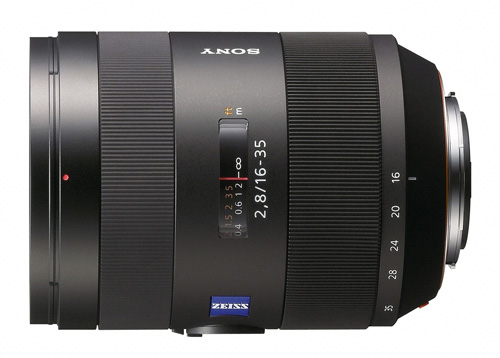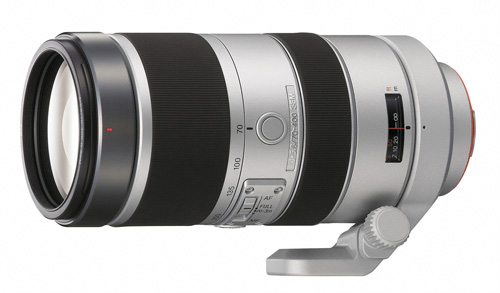Sony A900 Full-Frame: Hands-On Preview
by Wesley Fink on September 12, 2008 12:00 AM EST- Posted in
- Digital Camera
New Zeiss 16-35mm f/2.8 and 70-400mm f/4-5.6 G Lenses
SAN DIEGO, Sept. 9, 2008 - Sony is expanding its number of high performance Carl Zeiss and G Series lenses with the addition of the new SAL1635ZA and SAL70400G models.
Vario Sonnar T* 16-35mm f/2.8 ZA Carl Zeiss Series Lens

The SAL1635ZA model is a super wide-angle 16-35mm f/2.8 constant aperture zoom lens, well suited for landscape, snapshot, and indoor photography. It is constructed of 17 lens elements in 13 groups, including an extra-low dispersion (ED) for exceptional clarity and center-to-edge resolution and a super ED glass element for much stronger correction of chromatic aberration or discoloration. It also features three aspherical lens elements that provide greater brightness from center to the edge of the image field. Its Carl Zeiss T* (T star) coating technology provides higher light transmission, and minimizes flare to produce images of luminous clarity, color and sharpness.
The SAL1635ZA lens offers the utmost flexibility in challenging lighting conditions due to its wide f/2.8 constant aperture. Combined with Sony's in-camera SteadyShot Inside image stabilization system, this lens is the only large aperture, full-frame capable, wide-angle zoom lens with the benefit of stabilization in the industry. Smooth, fast, and precise focusing is delivered by Sony's Super Sonic wave Motor (SSM) autofocus drive system. It utilizes a solid-state focus drive motor to provide silent, high-speed response, powerful torque, and fine rotational control - critically important for large wide-aperture lenses.
70-400mm f/4-5.6 G Series Lens

The SAL70400G lens is a 5.7x super telephoto zoom lens and the latest addition to Sony's G-series line of premium lenses. Designed to deliver extremely sharp descriptive performance across its wide focal length range, it is ideally suited for sports, action, and wildlife photography. Constructed of 18 elements in 12 groups, it includes two extra-low dispersion glass lenses for high contrast, sharp details, and exceptional center-to-edge resolution with minimal chromatic aberration. A circular aperture with nine diaphragm blades is utilized to achieve natural, aesthetically pleasing de-focusing effects.
With a minimum focus distance of 1.5m and maximum magnification of 0.27x, the lens delivers best-in-class performance. Like the SAL1635ZA lens, focus drive is provided by its SSM system, which offers the speed and rotational precision often required for telephoto shooting. Additionally, the lens has an internal focusing system for faster autofocusing.
A focus-mode/range switch and three focus-hold buttons have been added to the lens barrel for enhanced operability. For both models, when attached to the flagship α900 camera body, the AF hold buttons can be customized to activate the intelligent preview function.
Price and Availability
The Vario-Sonnar T* 16-35mm f/2.8 ZA and 70-400mm f/4-5.6 G lens will ship in January 2009 for about $1,800 and $1,500, respectively.










53 Comments
View All Comments
roweraay - Saturday, September 13, 2008 - link
Obviously, an APS-C 100% viewfinder is only 42% of the size of a Full-frame viewfinder at equivalent magnification. That is a point one has to really keep in mind.Note that the 100% viewfinder at 0.74x magnification, is larger than the viewfinders in the Nikon D3 or the Nikon D700 or the Canon 1DSMKII or the Canon 5D.
In fact, the Sony A900's viewfinder is the 2nd largest Viewfinder EVER, in any DSLR, with the $8000 Canon 1DSMKIII slightly edging it out in size. Note that the precision assembly required and the tighter manufacturing tolerances in a 100% viewfinder, makes it head-and-shoulders above even a 95% viewfinder.
The viewfinder sizes are as below:
Nikon D3: 100% VF with 0.7x magnification
Nikon D700: 95% VF with 0.72X magnification
Canon 5D: 96% VF with 0.71x magnification
Canon 1DSMKII: 100% with 0.7x magnification
Canon 1DSMKIII: 100% VF with 0.76x magnification
Kudos to Sony for getting this in at such a price and specification. Coupled with the fact that only the Sony Full-frame will have stabilized 35mm primes, 50mm primes, 85mm primes, 135mm primes, along with a stabilized 16-35 f/2.8, a stabilized 24-70 f/2.8 etc., makes this a VERY appealing product.
I personally DEFINITELY intend to "vote" for this with my money.
roweraay - Saturday, September 13, 2008 - link
Also note that the Sony Full-RAW files are around 40MB in size, per file, when it comes to the A900.So when shooting RAW at 5FPS, that is around 200MB of image data PER second.
When shooting RAW+JPEG at 5FPS, we need to add another 100MB to the above number, thus taking us to 300MB of data PER SECOND.
What the above means is that the data pipeline architecture needed to support 24.6MP of resolution at 5FPS, is literally equivalent to the data pipeline architecture of MUCH pricier products like the 1DSMKIII and the Nikon D3. This is WAY superior to the architecture in products like the Nikon D700 or the Canon 5D (current version).
Also, dpreview tests show that the A700 is WRITING to the CF-card at around 37MB/Sec, when tested with a 40MB/Sec Sandisk Extreme IV card (max speed: 40MB/Sec). In other words, the A700 is WRITING to the card at almost the full speed of a 266x 40MB/Sec UDMA card. I would assume that with a 300x 45MB/Sec card, it very well might have broken the 40MB/Sec write-to-card speed barrier.
When mentioning the above write-to-card speeds, I need to point out that the above speeds are faster than any other dSLR, regardless of cost. It is faster than the Canon 1DSMKIII, 1DMKIII, Nikon D3, Nikon D300, Nikon D700 etc. Only the Nikon D3/D300 come relatively close to the A700's write-to-CF-card speed.
I would not be surprised if the A900 is even faster, if we employ a 45MB/SEC 300X card to test its write-to-card speed.
I would venture that Sony is employing the full power of its electronics expertise in their high-end pro/semi-pro level cameras.
chiew - Sunday, September 14, 2008 - link
wow...it can beat a three year old camera in write speed. kudos, sony!roweraay - Sunday, September 14, 2008 - link
Maybe you did not read it well enough. ;)The one-year-old Sony A700, is beating every single DSLR *ever* made, regardless of pricepoint, in the write-to-card speed.
The A900 could match it or maybe be even faster !
chiew - Sunday, September 14, 2008 - link
how much does write speed really matter, though?is there any data on 1D mkIII write speeds? because based on more important things, like frames per second, color depth, etc, cameras like the 1d mkIII and nikon d3 have to write pretty damn fast. . i know write speed to card is part of the pipeline, but as long as the camera writes fast enough to keep up with its rated specs, i don't see why write speed is such a huge deal
a700: 5 frames per second, 12 bit, 12 mp
40d: 6.5 fps, 14 bit, 10 mp
1d mkIII: 10 fps, 14 bit, 10 mp
one example of a camera that doesnt keep up is the d300, which when switched into 14 bit mode, cannot keep up with its 6 fps.
Wesley Fink - Saturday, September 13, 2008 - link
A catalog photographer at the Sony presentation has been shooting with the A900 for several weeks. He was a Canon 1Ds Mark III user He also was a user for many years of Hasselblads with Zeiss glass and digital backs. The Zeiss lenses were a big part of his move to Sony.This same photographer quoted the largest capture file size as 68MB, but your 40MB is much closer to the published specs in the A900 brochure. Those charts show a 4GB card can capture 105 full RAW files or 157 cRAW.
I suspect the PRO was referring to the file size of a finished TIFF saved from processing a RAW image since he mentioned he used Capture One for most of his PP. Frankly I didn't know Capture One supported the A700 until he assured us he had used it for his PP with the A700. Capture One will also apparently support the A900 by the time it is shipping. Since the program is widely used by Pros that will be important to many.
roweraay - Sunday, September 14, 2008 - link
The biggest draw for me are the Zeiss AF lenses in the Sony range, too. Specifically the CZ 85mm f/1.4 Planar, the CZ 135mm f/1.8 Sonnar, the CZ 24-70 f/2.8 SSM Vario-Sonnar and the 16-35 f/2.8 SSM Vario-Sonnar. I already have the 85mm and the 24-70 f/2.8 with me and will add the 135 (shortly) and the 16-35 f/2.8 when it becomes available.There were some rumors that there is also an upcoming Carl Zeiss 70-200 f/2.8 SSM Vario-Sonnar, which if true, would provide f/2.8 from 16mm to 200mm. This lens is rumored to replace the current 70-200 f/2.8G SSM (from the Konica-Minolta era).
Wesley Fink - Saturday, September 13, 2008 - link
D3 and not D4. I wish I really had a D4 but it was just a slip of the finger.Rashkae - Saturday, September 13, 2008 - link
Sony does not target this at Pros. It's officially semi-pro, and they said "it's a camera that even pros might want to use".And have you held it? Used it? I have. It's build is so seriously solid it impressed a die-hard D3 user. Don't dismiss the ruggedness of this body, when even the lower-spec A700 survived in conditions the Canon 1Ds-MkIII died in.
melgross - Wednesday, September 17, 2008 - link
They are calling it a pro body here. That's what I'm talking about.And thats pure BS about the A700 vs the 1Ds. I've used the 1Ds and you could use it as a hammer to smash the A700 to a pancake, then go out to shoot some sports.